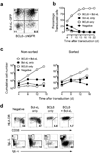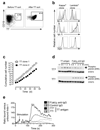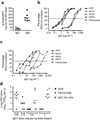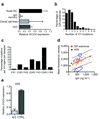Generation of stable monoclonal antibody-producing B cell receptor-positive human memory B cells by genetic programming
- PMID: 20023635
- PMCID: PMC2861345
- DOI: 10.1038/nm.2071
Generation of stable monoclonal antibody-producing B cell receptor-positive human memory B cells by genetic programming
Erratum in
-
Corrigendum: Generation of stable monoclonal antibody-producing B cell receptor-positive human memory B cells by genetic programming.Nat Med. 2016 Dec 6;22(12):1502. doi: 10.1038/nm1216-1502a. Nat Med. 2016. PMID: 27923028 No abstract available.
Abstract
The B cell lymphoma-6 (Bcl-6) and Bcl-xL proteins are expressed in germinal center B cells and enable them to endure the proliferative and mutagenic environment of the germinal center. By introducing these genes into peripheral blood memory B cells and culturing these cells with two factors produced by follicular helper T cells, CD40 ligand (CD40L) and interleukin-21 (IL-21), we convert them to highly proliferating, cell surface B cell receptor (BCR)-positive, immunoglobulin-secreting B cells with features of germinal center B cells, including expression of activation-induced cytidine deaminase (AID). We generated cloned lines of B cells specific for respiratory syncytial virus and used these cells as a source of antibodies that effectively neutralized this virus in vivo. This method provides a new tool to study B cell biology and signal transduction through antigen-specific B cell receptors and for the rapid generation of high-affinity human monoclonal antibodies.
Figures




 ), AM16 (○), and AM23 (
), AM16 (○), and AM23 ( )
compared to palivizumab (Δ). (c) Neutralization dose response curve of the RSV antibodies D25, AM14, AM16, AM23 and palivizumab against the primary RSV isolate X. Symbols as in 4b (d) Effects of rD25 (●), palivizumab (Δ) and a control IgG1 (×) on RSV replication in cotton rat lungs. Antibodies were administered i.m. one day before intranasal challenge with RSV X (106 TCID50/animal). Lung virus titers were calculated per gram of lung tissue; control prophylaxis reached a titer of 4.7 log TCID50 g−1, while the lower limit of detection was 2.1 log10TCID50 g−1.
)
compared to palivizumab (Δ). (c) Neutralization dose response curve of the RSV antibodies D25, AM14, AM16, AM23 and palivizumab against the primary RSV isolate X. Symbols as in 4b (d) Effects of rD25 (●), palivizumab (Δ) and a control IgG1 (×) on RSV replication in cotton rat lungs. Antibodies were administered i.m. one day before intranasal challenge with RSV X (106 TCID50/animal). Lung virus titers were calculated per gram of lung tissue; control prophylaxis reached a titer of 4.7 log TCID50 g−1, while the lower limit of detection was 2.1 log10TCID50 g−1.
Similar articles
-
Genetic manipulation of B cells for the isolation of rare therapeutic antibodies from the human repertoire.Methods. 2014 Jan 1;65(1):38-43. doi: 10.1016/j.ymeth.2013.07.002. Epub 2013 Jul 15. Methods. 2014. PMID: 23867338
-
Establishment of Systems to Enable Isolation of Porcine Monoclonal Antibodies Broadly Neutralizing the Porcine Reproductive and Respiratory Syndrome Virus.Front Immunol. 2019 Mar 27;10:572. doi: 10.3389/fimmu.2019.00572. eCollection 2019. Front Immunol. 2019. PMID: 30972067 Free PMC article.
-
Stable long-term cultures of self-renewing B cells and their applications.Immunol Rev. 2016 Mar;270(1):65-77. doi: 10.1111/imr.12395. Immunol Rev. 2016. PMID: 26864105 Free PMC article. Review.
-
CD40 ligand and appropriate cytokines induce switching to IgG, IgA, and IgE and coordinated germinal center and plasmacytoid phenotypic differentiation in a human monoclonal IgM+IgD+ B cell line.J Immunol. 1998 Mar 1;160(5):2145-57. J Immunol. 1998. PMID: 9498752 Free PMC article.
-
Affinity enhancement of antibodies: how low-affinity antibodies produced early in immune responses are followed by high-affinity antibodies later and in memory B-cell responses.Cancer Immunol Res. 2014 May;2(5):381-92. doi: 10.1158/2326-6066.CIR-14-0029. Cancer Immunol Res. 2014. PMID: 24795350 Review.
Cited by
-
Development of Therapeutic Monoclonal Antibodies for Emerging Arbovirus Infections.Viruses. 2023 Oct 30;15(11):2177. doi: 10.3390/v15112177. Viruses. 2023. PMID: 38005854 Free PMC article. Review.
-
Human B cells and dendritic cells are susceptible and permissive to enterovirus D68 infection.mSphere. 2024 Feb 28;9(2):e0052623. doi: 10.1128/msphere.00526-23. Epub 2024 Jan 23. mSphere. 2024. PMID: 38259063 Free PMC article.
-
Molecular Evolutionary Analyses of the Fusion Genes in Human Parainfluenza Virus Type 4.Microorganisms. 2024 Aug 9;12(8):1633. doi: 10.3390/microorganisms12081633. Microorganisms. 2024. PMID: 39203475 Free PMC article.
-
The Respiratory Syncytial Virus (RSV) G Protein Enhances the Immune Responses to the RSV F Protein in an Enveloped Virus-Like Particle Vaccine Candidate.J Virol. 2023 Jan 31;97(1):e0190022. doi: 10.1128/jvi.01900-22. Epub 2023 Jan 5. J Virol. 2023. PMID: 36602367 Free PMC article.
-
Control systems and decision making for antibody production.Nat Immunol. 2010 Aug;11(8):681-8. doi: 10.1038/ni.1900. Epub 2010 Jul 20. Nat Immunol. 2010. PMID: 20644574 Review.
References
-
- Close PM, Pringle JH, Ruprai AK, West KP, Lauder I. Zonal distribution of immunoglobulin-synthesizing cells within the germinal centre: an in situ hybridization and immunohistochemical study. J Pathol. 1990;162:209–216. - PubMed
-
- Liu YJ, Arpin C. Germinal center development. Immunol Rev. 1997;156:111–126. - PubMed
-
- Muramatsu M, et al. Specific expression of activation-induced cytidine deaminase (AID), a novel member of the RNA-editing deaminase family in germinal center B cells. J Biol Chem. 1999;274:18470–18476. - PubMed
-
- Muramatsu M, et al. Class switch recombination and hypermutation require activation-induced cytidine deaminase (AID), a potential RNA editing enzyme. Cell. 2000;102:553–563. - PubMed
-
- Allen CD, Okada T, Tang HL, Cyster JG. Imaging of germinal center selection events during affinity maturation. Science. 2007;315:528–531. - PubMed
Publication types
MeSH terms
Substances
Grants and funding
LinkOut - more resources
Full Text Sources
Other Literature Sources
Research Materials

